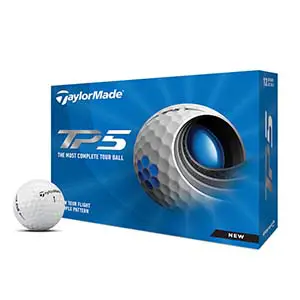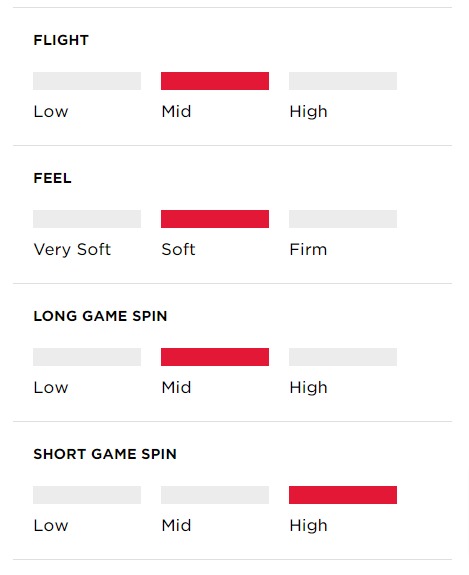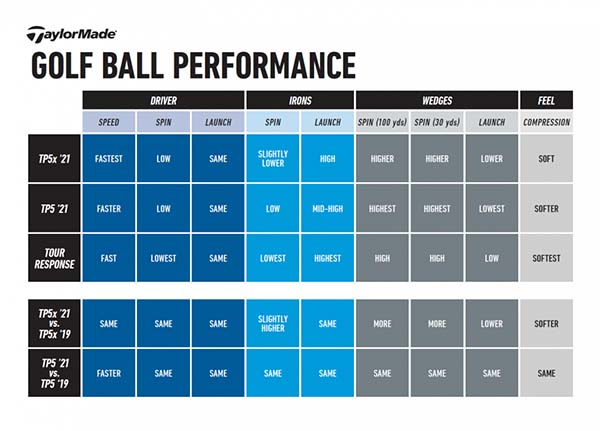The Titleist ProV1 and the TaylorMade TP5 are two of the most popular premium golf balls on the market. But how do they compare to each other and which one should you be playing?
The ProV1 is the self-proclaimed most popular ball in golf, but the TP5 is gaining traction since it first showed up.
The main difference between the ProV1 and the TP5 is that the ProV1 will feel a little softer and give you more spin with your irons and wedges as well as more spin around the greens while the TP5 should give you a slightly higher launch throughout the bag.
Here’s how they stack up against each other after testing both models on Trackman…
ProV1 vs. TP5 Comparison Chart
Titleist
Pro V1
3-Piece
Urethane Cover
Very Soft Feel
Mid Ball Flight
Most Short Game Spin
Lower Driver Spin
Low Wedge Launch
Slightly Shorter Drives

Taylormade
TP5
5-Piece
Urethane Cover
Slightly Firmer Feel
Mid-High Ball Flight
High Short Game Spin
Lower Driver Spin
Low Wedge Launch
Slightly Longer Drives

Titleist ProV1
The Titleist ProV1 has been the standard on which we judge golf balls for years. It’s also the most popular golf ball on the PGA Tour.
While PGA players are paid to play certain equipment, they still need to play well to keep those lucrative contracts, so despite the monetary incentive, that many pros using them is a good sign that these are solid golf balls.

Taylormade TP5
The TaylorMade TP5 was released in 2017 as the first 5-layer golf ball. Since then, it has been played by some of the most notable names in golf, including Dustin Johnson, Rory McIlroy, and even Tiger Woods.
The TP5x is very similar to the TP5 and is designed to be a little firmer, launch slightly lower with irons, and spin less with the irons and wedges. You can see the chart below that TaylorMade released to show the difference between its two premium models.

So as you can see from this chart, the TP5 is going to perform very similar to the TP5x and you can see my in-depth comparison between the TP5 and TP5x here.
But as compared to the ProV1, the TP5 is going to be a little firmer overall and probably fly a little farther off the driver if your diver swing speed is 95+ mph. Less than
Design
The TP5 is a 5-piece ball and the ProV1 is a 3-piece ball. Aside from this obvious difference, they are actually similar from a practical standpoint, just using a different number of layers to achieve the same result.
TaylorMade claims that their 5-piece design allows the TP5 to perform at it’s peak for all types of shots. The layers get progressively firmer as you go from the cover to the core. This allows you to activate each layer based on the club you are using (or specifically the club speed each club generates).
The ProV1 is a 3 piece ball but applies the same principles to it’s design in order to create optimal spin and launch conditions throughout the bag.
Ball Flight Trajectory
Based on the materials put out by each of the manufacturers, I would expect the ProV1 and TP5 to have similar ball flight trajectories off of the driver.
However, the difference in firmness should make a small difference in the ball flight off irons and wedges. Taylormade considers the TP5 the lowest flying ball in its lineup when using irons and wedges. The only information Titleist gives regarding ball flight is calling it “mid.”
But iron and wedge trajectory is often a result of the softness of a golf ball. The ProV1 is softer than the TP5 so you can expect slightly lower flying shots with the ProV1 off the irons and wedges, but likely with more spin.
If you often play very fast and dry greens then spin may not be enough to hold greens with your long irons. You’ll need a higher trajectory.
Spin
Spin is one of the major aspects of ball-flight that can be influenced significantly by ball choice.
After testing both balls on a Trackman, here are the spin numbers…
| Driver | 7 iron | Partial Wedge | |
|---|---|---|---|
| TP5 | 2450 rpm | 7098 rpm | 7696 rpm |
| ProV1 | 2412 rpm | 6893 rpm | 8394 rpm |
Driver Spin
The ideal rate of driver spin is dependent on your swing speed. Faster swinging players typically need to minimize spin to prevent the ball from ballooning and dropping short while slower swing speed players need spin to keep the ball from falling out of the sky too soon.
Spin numbers off the driver were fairly consistent between these two golf balls. Both of them were in the 2400 rpm range based on my average driver swing speed of 103-104mph.
Both the ProV1 and the TP5 are designed for golfers that have driver swing speeds of at least 95 mph or more. If you swing your driver slower than that, I would recommend checking out some of these golf balls for slower swing speeds.
Iron Spin
Iron spin needs to cast a balance between distance and stopping the ball on the green when you hit it.
A golf ball’s second layer (just under the cover) is typically what impacts how the ball reacts off iron shots. An iron shot doesn’t compress the ball enough to activate the core and the cover is too thin to affect these types of shots.
The ProV1 and the TP5 are going to react very similarly off of both long and short iron shots.
Short Game Spin
Short game spin is what allows you to control the ball on chips and pitches from around the green. This is influenced almost entirely by the softness of the cover.
Premium golf ball covers are usually made of urethane, a soft and tacky material that gives you a lot of short game spin and is still quite durable. Both the TP5 and the ProV1 are made with urethane covers and will give you a lot of short game spin.
I think the ProV1 might edge out the TP5 slightly in terms of greenside spin, but the difference is far too minimal to notice in normal play. Your swing variance and environmental conditions such as dirt and moisture are going to have more of an effect than the difference between the TP5 and ProV1 here.
Distance
It is difficult to compare distance as a pure factor of the ball itself because the distance is highly dependent on the specific swing of the golfer. So it is more important to find a golf ball that fits your swing than finding the “best” golf ball.
So while distance is difficult to test objectively, one way to estimate the energy transfer from club to the ball is with the smash factor. Smash factor is calculated by ball speed/club speed. A “perfect” smash factor is 1.5 and most PGA Pros average somewhere around 1.47 to 1.49.
I used the same driver to hit both golf balls and eliminated the mis-hits to see if there was any significant difference in the smash factors between the TP5 and ProV1.
| Average Smash Factor | |
|---|---|
| TP5 | 1.444 |
| ProV1 | 1.390 |
The results were so close that I went out to the thousands place to show you a difference. Essentially, they were both 1.44. The TP5 and the ProV1 are going to be identical when it comes to energy transfer.
That’s why I created the golf ball selector tool to help you make a better decision when choosing a golf ball.
Feel
Contrary to popular belief, feel is the last thing you should consider when choosing a golf ball.
your “feel” preferences are determined largely by what you are currently used to. If you spend a little time using a firmer or softer ball, you’ll likely adapt to it quite easily. So rather than eliminate a golf ball based on how it feels, figure out which ball performs best for you first and then just spend some time getting used to it.
That being said, there is a slight difference in feel between the ProV1 and the TP5. The ProV1 feels slightly softer off the clubface. You can notice this from driver through the putter.
